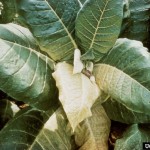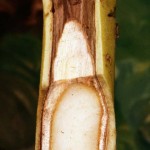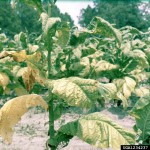Fusarium Wilt
Varieties with good resistance to Fusarium Wilt: SP 236
Pictures provided by R.J. Reynolds Tobacco Company Slide Set, R.J. Reynolds Tobacco Company, Bugwood.org and Clemson University – USDA Cooperative Extension Slide Series, Bugwood.org
Symptoms of Fusarium Wilt typically begin on one side of the plant. The leaves on the affected side begin to wilt and may begin to yellow. Caused by a soil-borne fungus, this disease causes the leaves to slowly yellow and dry out. On the affected side of the plant, there is a uniform brown discoloration of the entire woody tissue (vascular tissue). This brown discoloration of Fusarium Wilt is in contrast with the black streaking (lines) of Bacterial (Granville) Wilt. The unilateral appearance of the symptoms and presence of vascular discoloration can cause confusion between Fusarium Wilt and Bacterial Wilt. However, the presence of bacterial streaking lines described for bacterial wilt is a reliable way to distinguish between these two diseases. With Fusarium Wilt, some roots on the affected side simply die. Fusarium Wilt, like Bacterial Wilt, is usually accompanied by root knot nematode infestations.
Fusarium Wilt can survive in the soil for 10 years or more. It is a parasite that enters roots through wounds caused by nematodes or other root damages, reaches the plant’s vascular system and spreads through the vessels, partially blocking them and reducing the plant’s water supplies.
The fungus may be spread to other fields by vegetables or weeds. To avoid Fusarium Wilt infestations, the use of resistant cultivars is recommended, but resistance is not complete. The use of nematicides and crop rotation are also necessary and beneficial for areas seriously infected with nematodes and Fusarium.


